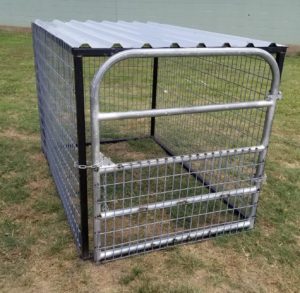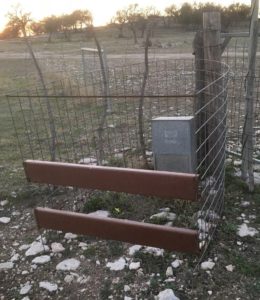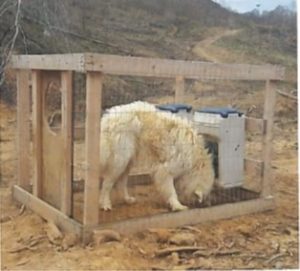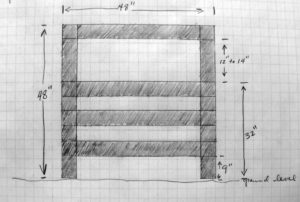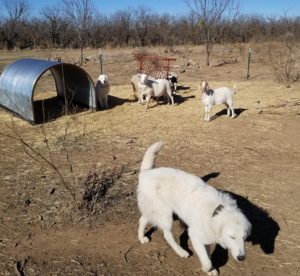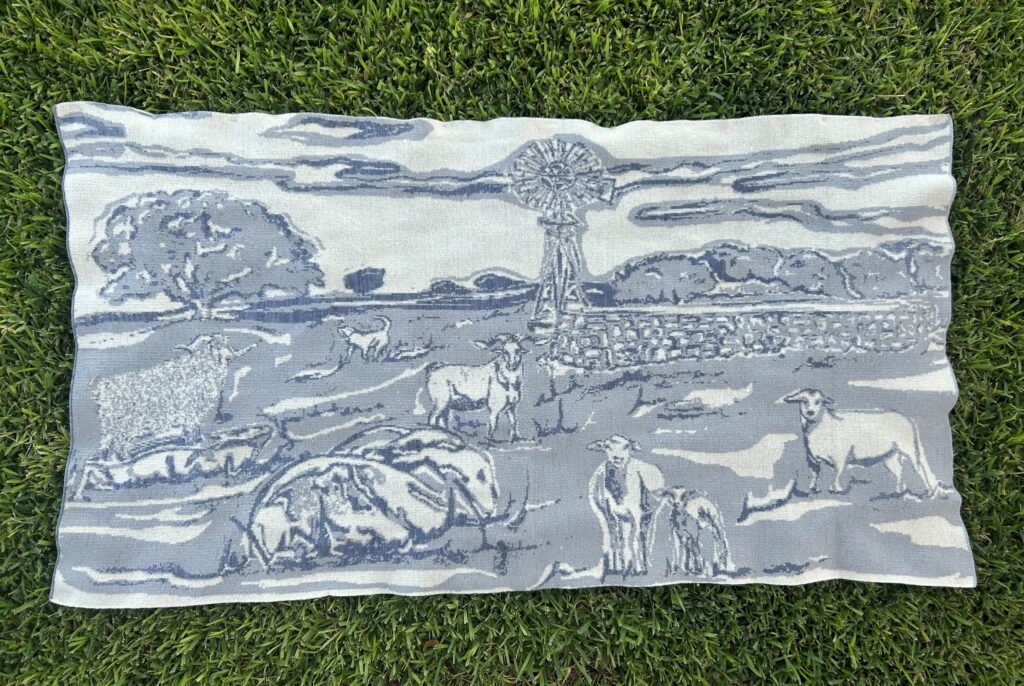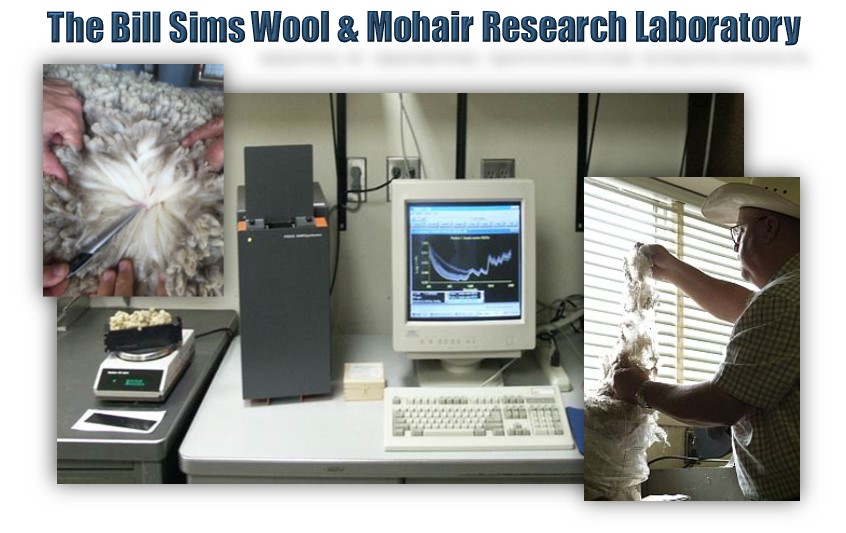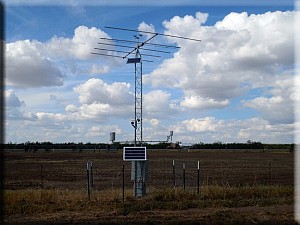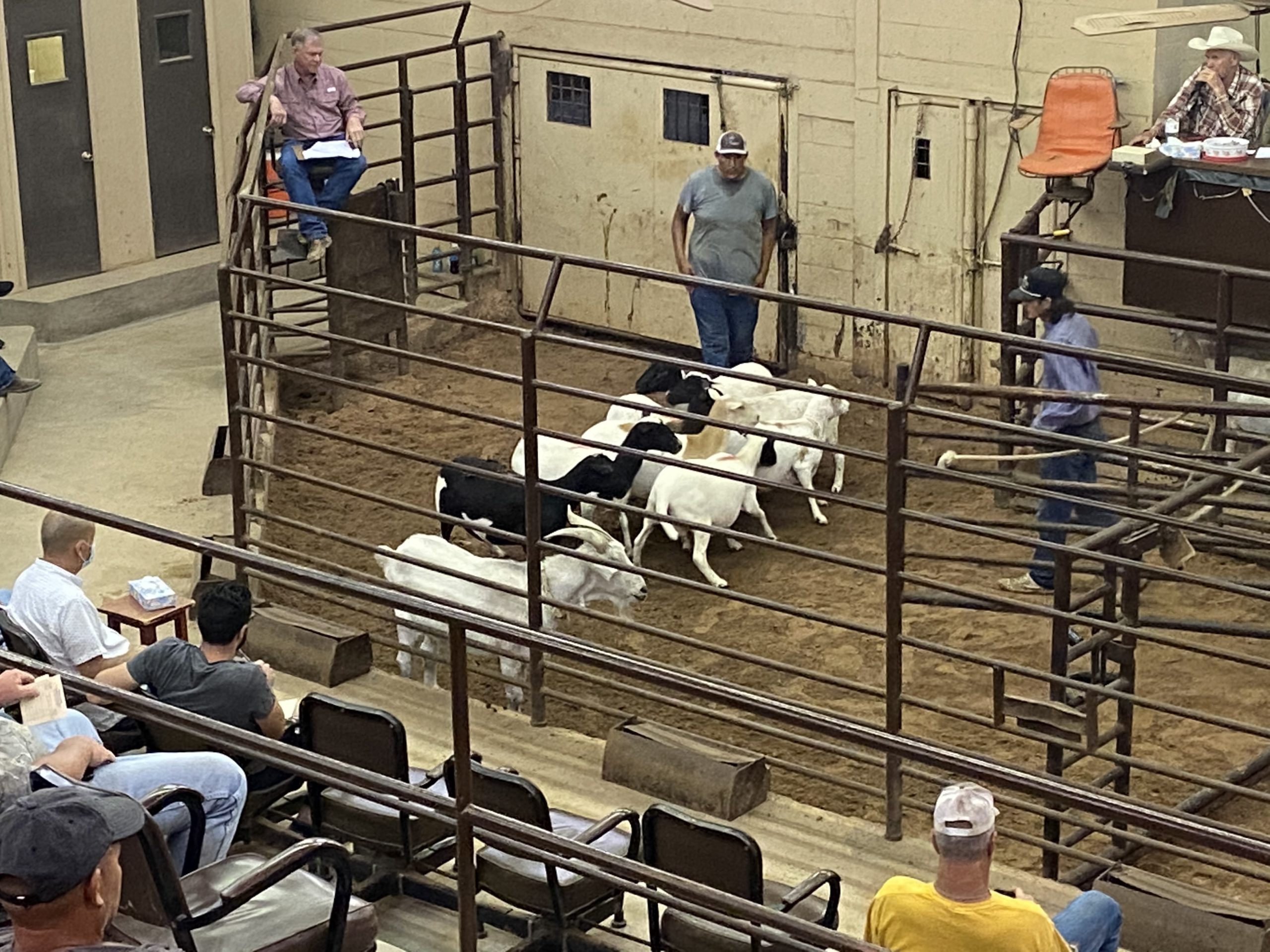Feeding Systems for LGDs:
One of the most common questions that producers with LGDs have is about is feeding their dog/s. Most owners choose to use self-feeders for convenience. There are several options available in a range of prices with and without automation. Using a self-feeder will keep you from being locked into a specific time to feed the dogs. It also means there is always free choice food available to the dogs, so they’re never away from the herd looking for food. They seem to stay quite healthy choosing when and how much to eat without our interference.
We have found that a self-feeder that holds 25-50 pounds works well. You’ll need one with a capacity that will hold enough to feed your dog/s for as long as possible without spoiling or becoming infested with insects. Daily consumption, heat, humidity, and insect activity in your area are the major issues affecting the amount of food you can effectively store in the feeder and still provide quality dog food. Relatively cheap human-safe insect pest strips are available that can be safely used to keep them away. Placing the legs of the feeder in containers of thin oil will also keep crawling pests away. We made some improvements to our self-feeders such as extra rivets, handles, locks and hooks to secure them to our feeding stations. I also use fender washers so that it’s harder for the handles and hooks to pull out from the thin metal as seen in the pictures. 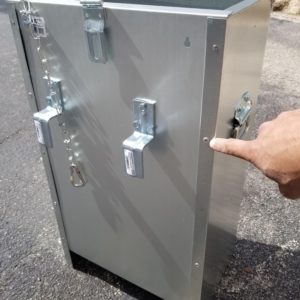
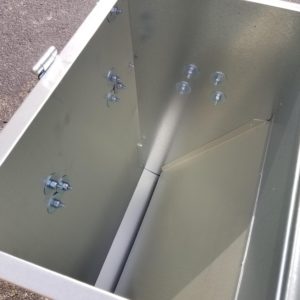
A self-feeder alone may not be the complete answer. You need to allow your dog’s access to the feeder while denying access to the sheep/goats. The method is quite simple: surround the feeder with a sturdy fence, cut a hole in the fence too high and too small for a lamb/goat to jump through, but placed just right for your dog. However, scavengers, such as raccoons, skunks, and various birds, will be attracted to self-feeding stations and careful consideration should be taken to limit their ability to access the feeder. In a game camera study done at the Martin Ranch in 2017, hogs used the feeding station 58% of the time, LGD 20% of the time and raccoons 14% of the time. By changing our feeding station design we have been able to decrease feed costs along with repair costs to our feeders.
I have included a picture of the feeding station we use with a gate, along with three other ideas that producers in our area use. If they keep livestock out, they are a good design!
You can also place hog panels, cattle panels and/or utility panels around the feeder and cut a hole in the panel about 30-32 inches off the ground with the hole being 12-14 inches square or round depending on the dog’s size. Some producers have found that a horizontally placed, rectangular hole works better. You can also use a small gate or something else if the dogs can get in and the sheep or goats can’t, it will work. Make sure any sharp edges or points are smoothed off to protect the dogs when they go through because it can be a tight fit for them. Pictured is a simple wood jump panel made from 2×6 boards and bolts we use on some feeding stations at the AgriLife Center. The spacing can be changed to fit your dogs size. Make sure to keep the opening high enough and small enough so that livestock can’t enter the feeder.
To teach the dogs to use a feeding station, place them in the enclosure, show them the food and then lock them in. They can almost always figure out how to get back out. You need to check though- just in case they can’t. You may have to do this a few times before they figure out the system. Make sure to check your feeding station on a regular basis. You should have enough feed in the feeder to supply your dogs with enough kibble until you can return. Its best to have more than needed just in case you can’t make it back to check in time! You may also want to place a game camera on your feeding station to monitor whats eating your dog food besides your LGD.
The pups are all still doing well. The Stooges continue to stay in their pasture and have not left yet. They have not crossed a gate opening yet either. The bond between the dogs seems to be changing. Moe is separating from Larry and going with Curly now, but he is still the leader of the three. The Stooges seem to have formed a stronger bond to their Angora and Meat goat charges than their sheep pen mates for some reason. They are also getting more aggressive to threats each week.
Thor developed a heat rash around his neck from the tracker collar and had a puncture wound to a front paw a few weeks ago. Both issues required medication from the vet’s office. Luckily for me, but unfortunately for Thor they happened at the same time, so an extra visit wasn’t required. Both injuries have healed up well and he is doing fine. Goliath continues to stay with the stock while Thor and Hulk like to go on adventures to other pastures at the Center. They return on their own to their charges most of the time after an hour or two. Twice I had to return them to their pasture when they roamed too far. They seemed lost when I found them each time. There hasn’t been a pattern develop so I’m not sure if they are chasing varmints/predators or wandering out of curiosity.
Breed Spotlight – Maremma
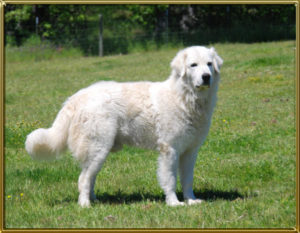 Larry, Moe & Curly, three of the pups in the current bonding project at the AgriLife Center in San Angelo, are purebred Maremma. I thought it would be helpful to everyone out there that is following the pups progress to have some background information on this breed also.
Larry, Moe & Curly, three of the pups in the current bonding project at the AgriLife Center in San Angelo, are purebred Maremma. I thought it would be helpful to everyone out there that is following the pups progress to have some background information on this breed also.
The Pastore Maremmano Abruzzese, or Maremma Sheepdog, originated in Italy where it has been used for many centuries as a flock guardian for sheep and goats in the plains and mountains. It was first imported into the United States for this purpose in the early 1970’s. The Maremma Sheepdog is derived from the ancient shepherd dogs used in the Maremma and Abruzzes regions of Italy. At one time the dogs from these two regions were considered two different breeds, but since about 1860 they have been crossed to the point that they are now recognized as one breed. Maremma is an American version of the Italian name “Maremmano-Abruzzese”. It is pronounced: ‘Mare’ as it is pronounced for a female horse, and ‘Emma’ as it is pronounced for a girl’s name.
The Maremma Sheepdog is a big, strongly built dog. They are heavily built, and slightly longer than tall in proportion. Their head is large, flat and conical in shape, resembling a bear. The chest is deep and well rounded. The ribs are long and well sprung with a level topline. The loin is long and very broad with little tuck up. The dog’s range in weight from 77 to 100 pounds for males and 66 to 88 pounds for females. The Maremmas are very protective of their charges and human masters. They will not allow anyone that they feel is a threat to harm either of them. I can speak to this with experience as I have a LGD that is half Maremma. He will put himself between anyone in my family and a new person. He will push you until you move away. He is also protective of our livestock with new people or predators.
Their coat is somewhat long, harsh, straight, and held close to the body. A slight wave is sometimes seen. The hair forms a collar around the neck, and limited fringing on the back of the thighs. The hair is short on the face, ears and front of the legs. Body hair may be up to three inches in length. The undercoat is seasonal and sheds twice a year. They can tolerate extremely cold temperatures. Their skin is tight and thick, with black pigmentation of the mucous membranes, as well as, the third eyelids and toe pads. Their color is generally solid white. However, shades of pale ivory, orange or lemon are tolerated but not to extremes. https://www.ukcdogs.com/maremma-sheepdog and http://www.maremmaclub.com/maremma-faq.html
A good LGD can cost approximately $1,700 its first year and takes a lot of time to train properly. If you expect your LGD to properly protect your livestock, you need to make sure they are always healthy. Performing regular health checks on your LGDs will protect your investment in the dog and your lamb/kid crop. Having a well socialized and catchable dog makes this process much easier.
You should visually see you dog at least 3-4 times a week. The visual check should be close enough to see if the dog is limping or injured in any other way. A weekly hands-on check is important to catch any injuries before they get serious. Make sure to check your dog’s eyes, ears, nose, mouth, teeth, paws/pads and coat/skin for any injuries. Monthly health checks should include the weekly items in addition to checking their nails for overgrowth, body condition scoring and administration of flea and tick medication. Semiannual health checks should include the pervious items, as well as, administration of vaccines and dewormers. You may also need to shear your LGDs legs, belly, tail and chest. Completely shearing your LGDs body should be used with caution, as they can get a sunburn or lack the ability to regulate their body temperature.
Breeder Profile
In this new section of the Guardian Way, I will be spot lighting a LGD breeder that is effectively using LGDs in their operation. This month’s LGD breeder and rancher is Kristal Spenrath of Goldthwaite, Texas.
Q: Describe your operation/ranch.
- How many LGDs do you currently have?
- Explain your LGD program.
A: Together with my husband, Glenn, we raise fine wool sheep, Angora goats and beef cattle. The mohair and wool we raise goes into our Krazy Goat Socks. We have several pastures that we rotate the livestock through in order to best use the forage we have available.
We have 10 dogs right now. My dogs are divided up between the goats and sheep mostly. I have two Kangal Dogs with the cows in order to keep the buzzards away. We have been using Invisible Fence Brand fencing for 5 years now and this has been a life saver for us. Keeping the dogs on our property and safe from accidents has been well worth the expense. We can use the Invisible Fence to keep dogs in specific pastures with specific groups of animals. The way we use the Invisible Fence also allows us to safely snare our perimeter fence lines to control predators. This past year we snared 14 coyotes and 30 hogs. We use mostly neutered dogs because they are easier to manage. We use a few intact dogs that are a part of our purebred, registered breeding program.
However we have some Kangal Dogs also.
Q: Do you have an LGD mentor?
A: I would have to say that Tamara Taylor of Era, Texas has been a very important LGD mentor for me. She has been using LGDs since 1985 and she has been using purebred dogs the entire time. She is a great advocate for the Akbash Dogs and Kangal Dogs. She has a great understanding about genetics, bloodlines, physical conformation and what it takes to be a successful and ethical breeder. My Dad, James Stotts, is also a great source of information as well. Even though we both use Akbash Dogs, he utilizes his dogs in a little bit different way and I enjoy hearing his perspective.
Q: What’s the one thing you wish you knew before starting to breed LGDs?
A: The one thing that I wish I had known before I started breeding LGDs would have to be a better understanding of how physical conformation effects the health and longevity of the breed. Large breed dogs tend to have joint issues, but I think it’s due in part to breeders not having a good understanding of how conformation effects longevity. Conformation is heritable. Straight hind legs, bad elbows and an undershot bite are all passed on to the offspring. A dog with a blown ACL is in just as much pain as a dog with Hip Dysplasia. Dogs with back legs that are too straight or dogs with elbows that turn out too far cannot run as fast or as far as a dog with good conformation. A proper overbite is essential to good health and a long life and few breeders know this information.
Q: What is the number one thing you recommend to a new LGD user?
A: The number one thing that I recommend to people wanting to use LGDs for the first time is to study the various breeds of dogs available. Pick the one breed that you believe will fit your situation best and has the behavioral characteristics that you want to work with. A dog’s behavioral characteristics are what we live and work with daily. Understanding and working with one set of behavioral characteristics is easier than trying to work with multiple behavioral characteristics that come with crossbreeding. An Akbash Dog will always act like an Akbash Dog.
LGD Timely Tips
E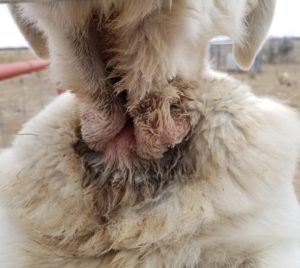 very Tuesday check out our Facebook page @TAMUlivestockguardog for Tuesday’s LGD tip of the Week.
very Tuesday check out our Facebook page @TAMUlivestockguardog for Tuesday’s LGD tip of the Week.
- Make sure to check your dog for hot spots or a rash on its neck if it wears a collar. They can develop within just a few days. The smelly wet rash seen here on Thor, occurred in less than three days from a collar. The area needs to be carefully cleaned and shaved with a close bladed. It’s also important to apply an antimicrobial spray to it daily until it completely heals. An anti-itch medication should also be applied once the area dries out.
- If your LGD is limping and you don’t see an obvious injury to the leg, check its paw for thorns and/or the pad for a puncture. Infections from thorns can spread rapidly and cause lameness. If the area is swollen and warm, the dog probably has an infection and will need antibiotics to recover.
To provide feedback on this article or request topics for future articles, please contact me at bill.costanzo@ag.tamu.edu or 325-657-7311.
Bill Costanzo
Research Specialist II, Livestock Guardian Dogs
Follow us on Facebook: https://www.facebook.com/TAMUlivestockguarddog/

